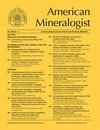Crystal chemistry of the monazite and xenotime structures
IF 2.3
3区 地球科学
Q2 GEOCHEMISTRY & GEOPHYSICS
引用次数: 549
Abstract
Abstract Monazite and xenotime, the RE(PO4) dimorphs, are the most ubiquitous rare earth (RE) minerals, yet accurate structure studies of the natural phases have not been reported. Here we report the results of high-precision structure studies of both the natural phases and the synthetic RE(PO4) phases for all individual stable rare earth elements. Monazite is monoclinic, P21/n, and xenotime is isostructural with zircon (space group I41/amd). Both atomic arrangements are based on [001] chains of intervening phosphate tetrahedra and RE polyhedra, with a REO8 polyhedron in xenotime that accommodates the heavy lanthanides (Tb-Lu in the synthetic phases) and a REO9, polyhedron in monazite that preferentially incorporates the larger light rare earth elements (La-Gd). As the structure “transforms” from xenotime to monazite, the crystallographic properties are comparable along the [001] chains, with structural adjustments to the different sizes of RE atoms occurring principally in (001). There are distinct similarities between the structures that are evident when their atomic arrangements are projected down [001]. In that projection, the chains exist in (100) planes, with two planes per unit cell. In monazite the planes are offset by 2.2 Å along [010], relative to those in xenotime, in order to accommodate the larger light RE atoms. The shift of the planes in monazite allows the RE atom in that phase to bond to an additional O2′ atom to complete the REO9 polyhedron.单氮石和xenotime结构的晶体化学
摘要:独居石和xenotime是稀土(RE)中最普遍存在的二晶型稀土(RE)矿物,但对其天然相的精确结构研究尚未见报道。本文报道了所有稳定稀土元素的天然相和合成RE(PO4)相的高精度结构研究结果。独居石为单斜晶,P21/n, xenotime与锆石(空间群I41/amd)呈等构造。这两种原子排列都基于[001]中间的磷酸盐四面体和稀土多面体链,其中xeno8多面体可容纳重镧系元素(合成相中有Tb-Lu),而独居石中的REO9多面体优先包含较大的轻稀土元素(La-Gd)。当结构从xenotime“转变”为monazite时,沿[001]链的晶体学性质是相似的,不同大小的RE原子的结构调整主要发生在(001)中。当它们的原子排列向下投射时,结构之间有明显的相似性[001]。在该投影中,链存在于(100)个平面中,每个细胞有两个平面。在独居石中,相对于xenotime中的平面沿[010]偏移2.2 Å,以便容纳较大的轻稀土原子。在独居石中,平面的移动允许该相的稀土原子与另一个O2’原子结合,以完成REO9多面体。
本文章由计算机程序翻译,如有差异,请以英文原文为准。
求助全文
约1分钟内获得全文
求助全文
来源期刊

American Mineralogist
地学-地球化学与地球物理
CiteScore
5.20
自引率
9.70%
发文量
276
审稿时长
1 months
期刊介绍:
American Mineralogist: Journal of Earth and Planetary Materials (Am Min), is the flagship journal of the Mineralogical Society of America (MSA), continuously published since 1916. Am Min is home to some of the most important advances in the Earth Sciences. Our mission is a continuance of this heritage: to provide readers with reports on original scientific research, both fundamental and applied, with far reaching implications and far ranging appeal. Topics of interest cover all aspects of planetary evolution, and biological and atmospheric processes mediated by solid-state phenomena. These include, but are not limited to, mineralogy and crystallography, high- and low-temperature geochemistry, petrology, geofluids, bio-geochemistry, bio-mineralogy, synthetic materials of relevance to the Earth and planetary sciences, and breakthroughs in analytical methods of any of the aforementioned.
 求助内容:
求助内容: 应助结果提醒方式:
应助结果提醒方式:


